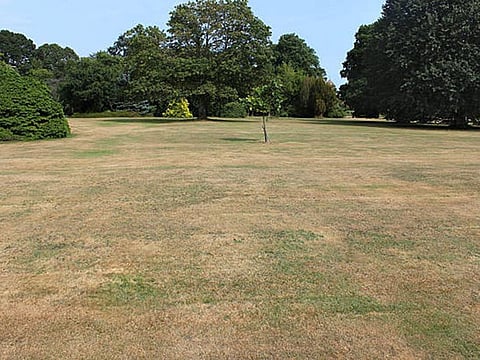Story of my glorious brown lawn
I shut down the sprinkler system and tested a new aesthetic, much to my delight

Watching golf on television, I found myself less interested in the scores than in the landscape. Browned-to-a-crisp terrain that in previous years struck me as strange and unattractive is now a source of comfort. In fact, it’s just like home.
The view from my window here in central California is of a front lawn almost as dried out as the fairways at Carnoustie, Scotland. Like many of my neighbours I’m concerned about climate change and with it the exorbitant price of water.
After my monthly bill tripled, I decided it was time for a new strategy. I shut down the sprinkler system and tested a new aesthetic. To my delight, I discovered that brown is beautiful.
Many lush lawns here are being ripped out and replaced by native plants that cast a hue of tan across the community, rather than anything that could be called emerald. Although the famed Pebble Beach Golf Links — where the US Open will be played next June — remains as green as ever, the neighbouring Poppy Hills course has changed.
During a rebuild four years ago, Poppy Hills replaced roughly 25 per cent of irrigated grass fairways with sandy, low-maintenance “waste areas.” Still, even the new eco-friendly layout requires more than $15 (Dh55) of water for every round played. I wonder: If that price were collected separately, how many golfers would prefer green cash over green fairways?
At my house the other day, a doe and her fawn strolled across the lawn, perhaps frustrated after discovering that it’s no longer as tasty as it used to be. The animals’ coats melded perfectly with the landscape, just as nature intended.
Interesting, isn’t it, how our perception of such things shifts over time and circumstance. Honestly, if our embattled local water company ever does build a desalination plant and the price of water goes down, I don’t know that I’d ever again want a field of green.
I grew up in Westchester County, New York, and was trained at an early age to regard every tiny patch of brown on our lawn as a plague of epic significance. My father and I watered and fertilised and mowed until each precious green blade was healthy and in place. My job, using a special forked tool, was to root out dandelions as soon as they appeared, catching them, at all cost, before they went to seed.
But while I’ve now come to appreciate my glorious brown lawn, not everyone sees it that way. A YouTube video titled How to Dominate Your Neighbor’s Lawn has had over 2.2 million views among those who believe that if you work hard enough, the grass can always be greener on your side of the fence.
Allyn Hane, who calls himself the Lawn Care Nut, describes in the video — and in dozens of others on his channel — steps needed to have the healthiest, greenest lawn in town.
Of course, Hane lives in Florida, where it rains almost every afternoon, while here in California it hasn’t rained in months. His is an alternate universe in which, he believes, “mowing is therapeutic.”
On a recent trip to Arizona, where drought conditions have persisted for nearly two decades, it was 112 degrees as I drove through Scottsdale. I noticed that many lawns have been replaced by beds of small, jagged red stones. No need to mow or irrigate — although you wouldn’t want to run across one of these yards barefoot.Maybe a red yard simply takes getting used to, sort of like purple hair.
I once did a Candid Camera experiment called “the Green Kid,” which came to mind as I gazed at my brown lawn. In the video, I told second-graders that a new child was enrolling at their school: a boy who happened to have green skin.
“That’s weird,” said one little guy.
Then he paused, collected his thoughts and told me: “Actually, it’s not really weird. It’s just different.”
— New York Times News Service
Peter Funt is a writer and TV host
Sign up for the Daily Briefing
Get the latest news and updates straight to your inbox



